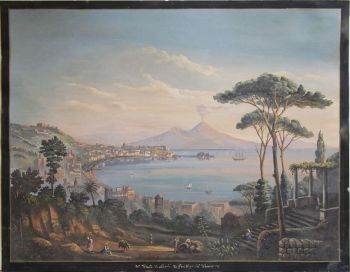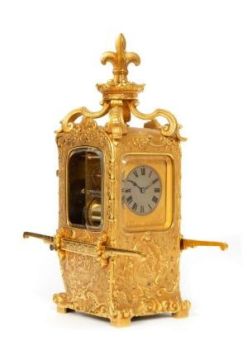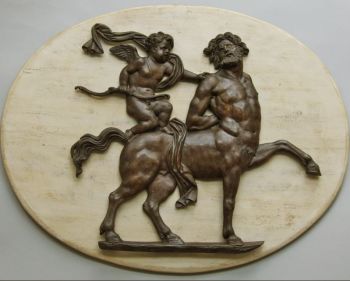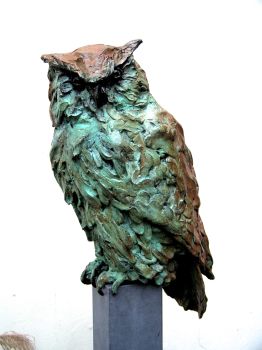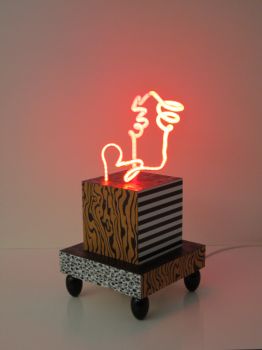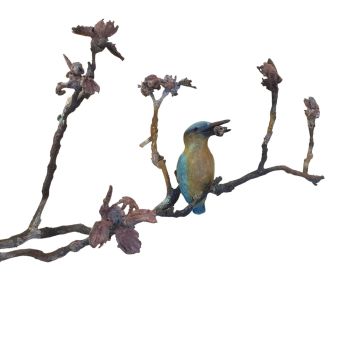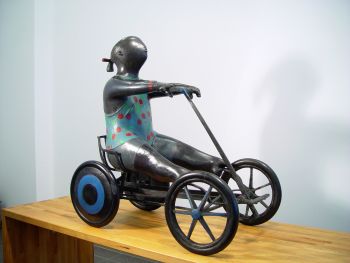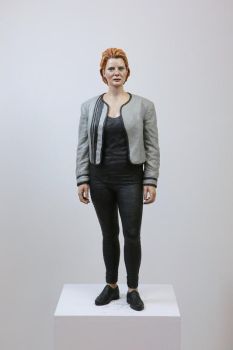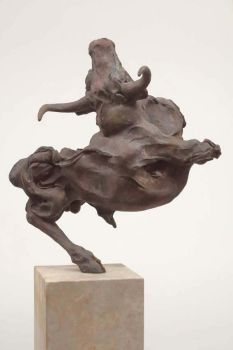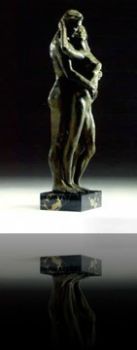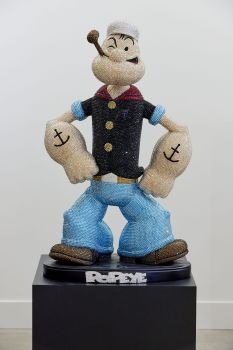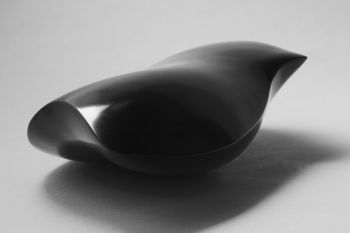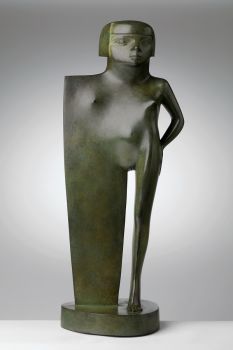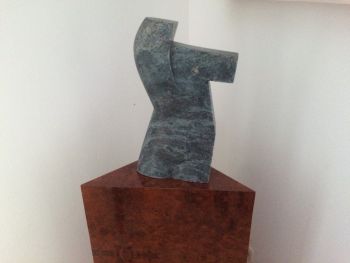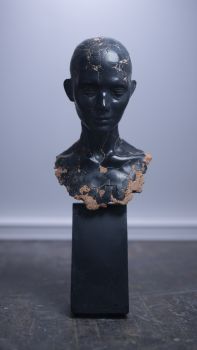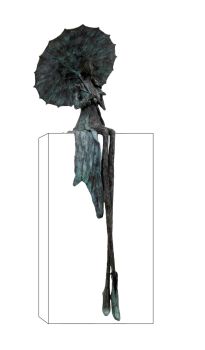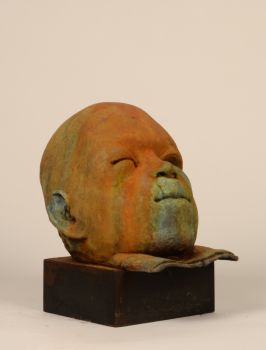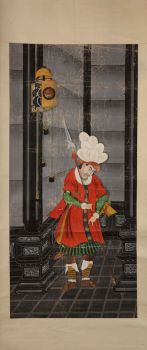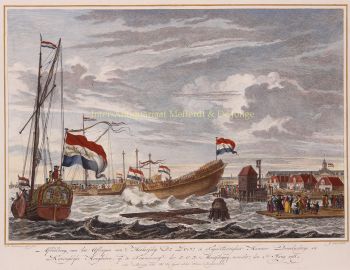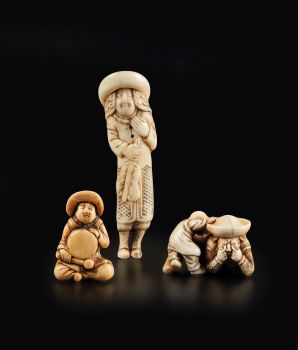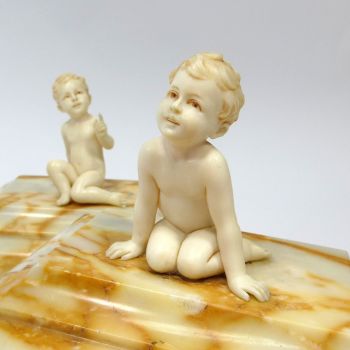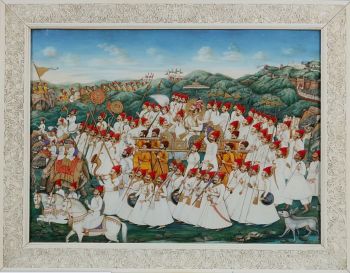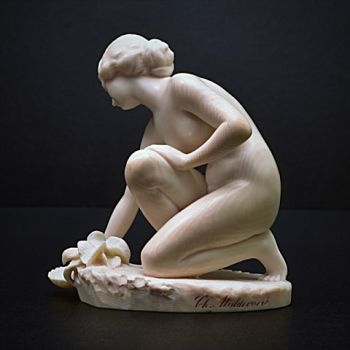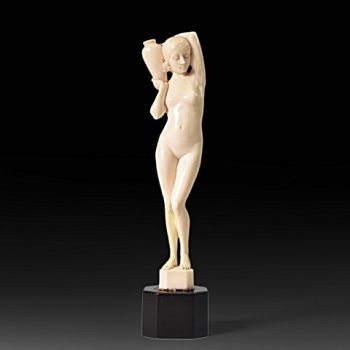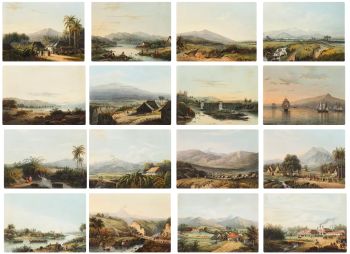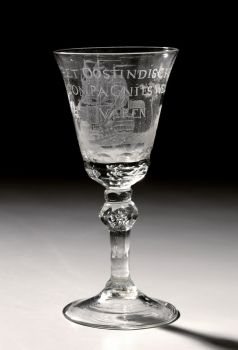Néerlandais en miniature (Netsuke) 1700 - 1900
Artiste Inconnu
Zebregs & Röell - Fine Art - Antiques
- Sur l'oeuvre d'art'Dutchmen in Miniature'
The portrayal of the Dutch by Japanese netsuke artists was popular in the 18th century and presents us with a fascinating insight into the Japanese perceptions of things foreign.
Foreigners, Ebisu, were considered bringers of good fortune, possessing magical power because they came from an unknown land and they came to be worshipped as deities. Netsuke of Dutchmen, therefore, were not only depictions of exotic appearances but probably had a talismanic function, such as warding off evil spirits, as well (Japan Envisions the West, 16th-19th Japanese Art from the Kobe City Museum).
Netsuke depicting Dutchmen constitute a clearly recognizable group of netsuke; Dutchmen are long, goggle-eyed, bow-legged, with a large nose and bad teeth. They wear a wide-brimmed hat with a feather or tassel, a bowler-hat or a seaman’s cap, a long coat decorated with Chinese motives of dragons, clouds or waves, over knickerbockers and long buttoned socks in low shoes
The portrayal of the Dutch by Japanese artists was popular from the late 18th and during most of the 19th century and presented us with a fascinating insight into the Japanese perception of things foreign. In many Japanese communities, mainly in the south, based on old myths and accessible wisdom, foreigners coming by ship from the South, were considered bringers of good fortune, possessing magical powers and coming from unknown southern lands. Netsuke of Dutchmen, therefore, were not only depictions of the exotic appearances of Westerners, but probably had talismanic functions as well, such as warding off evil and bringing wealth (for more netsuke of Dutchmen see Uit Verre Streken, November 2018). After Japan had been forced, in the 1850s, to open the country to Western powers, Japan quickly modernized, and the Japanese also started to adopt western clothing. This made an end to the use of and to a large extent to the making of netsuke and inro. - Sur l'artiste
Il peut arriver qu'un artiste ou un créateur soit inconnu.
Certaines œuvres ne doivent pas être déterminées par qui elles sont faites ou elles sont faites par (un groupe d') artisans. Les exemples sont des statues de l'Antiquité, des meubles, des miroirs ou des signatures qui ne sont pas claires ou lisibles, mais aussi certaines œuvres ne sont pas signées du tout.
Vous pouvez également trouver la description suivante :
•"Attribué à …." A leur avis probablement une oeuvre de l'artiste, au moins en partie
•« Atelier de …. ou « Atelier de » À leur avis, une œuvre exécutée dans l'atelier ou l'atelier de l'artiste, éventuellement sous sa direction
•« Cercle de… ». A leur avis une oeuvre de la période de l'artiste témoignant de son influence, étroitement associée à l'artiste mais pas forcément son élève
•« Style de … ». ou "Suiveur de ...." Selon eux, une œuvre exécutée dans le style de l'artiste mais pas nécessairement par un élève ; peut être contemporain ou presque contemporain
•« Manière de… ». A leur avis une oeuvre dans le style de l'artiste mais d'une date plus tardive
•"Après …." A leur avis une copie (quelle qu'en soit la date) d'une oeuvre de l'artiste
•« Signé… », « Daté… ». ou « Inscrit » À leur avis, l'œuvre a été signée/datée/inscrite par l'artiste. L'ajout d'un point d'interrogation indique un élément de doute
• "Avec signature ….", "Avec date ….", "Avec inscription …." ou "Porte signature/date/inscription" à leur avis la signature/date/inscription a été ajoutée par quelqu'un d'autre que l'artiste
Êtes-vous intéressé par l'achat de cette oeuvre?
Artwork details
Related artworks
Artiste Inconnu
Series of 6 Chinese cups and saucers (Yongzheng period)1722 - 1735
Prix sur demandeKuipers Kunst & Antiek
1 - 4 / 12- 1 - 4 / 24
Shiba Kokan
Peinture d'un hollandais fantastiqueearly 19th
Prix sur demandeZebregs & Röell - Fine Art - Antiques
Artiste Inconnu
UN MODÈLE JAPONAIS D'UN NORIMONO, UN PALANQUIN1650 - 1700
Prix sur demandeZebregs & Röell - Fine Art - Antiques
Artiste Inconnu
Japanese transition-style lacquer coffer 1640 - 1650
Prix sur demandeZebregs & Röell - Fine Art - Antiques
Artiste Inconnu
UN FILET D'IVOIRE D'UN DUTCHMAN TENANT UN COCKEREL18th century
Prix sur demandeZebregs & Röell - Fine Art - Antiques
 Sélectionné par
Sélectionné parDanny Bree
Artiste Inconnu
UN PLAT EN ARGENT LOBBED INDONÉSIEN INSOLITElate 17th
Prix sur demandeZebregs & Röell - Fine Art - Antiques
Artiste Inconnu
Néerlandais en miniature18th century
Prix sur demandeZebregs & Röell - Fine Art - Antiques
1 - 4 / 24Artiste Inconnu
GRANDE PEINTURE INDIENNE IMPORTANTE ET RARE `` STYLE D'ENTREPRISE '' SUR IVOIRE REPRÉSENTANT UN DÉFI1850 - 1900
Prix sur demandeZebregs & Röell - Fine Art - Antiques
 Sélectionné par
Sélectionné parDanny Bree
Artiste Inconnu
A Dutch colonial Indonesian betel box with gold mounts1750 - 1800
Prix sur demandeZebregs & Röell - Fine Art - Antiques
Artiste Inconnu
UN FILET D'IVOIRE D'UN DUTCHMAN TENANT UN COCKEREL18th century
Prix sur demandeZebregs & Röell - Fine Art - Antiques
Artiste Inconnu
A gem-set ivory sculpture of an Ottoman sultan1700 - 1750
Prix sur demandeZebregs & Röell - Fine Art - Antiques
1 - 4 / 24Artiste Inconnu
Néerlandais en miniature18th century
Prix sur demandeZebregs & Röell - Fine Art - Antiques
Abraham Salm
Twenty-four chromolithographs of Java after A. Salm”1801 - 1876
Prix sur demandeZebregs & Röell - Fine Art - Antiques
1 - 4 / 12




















